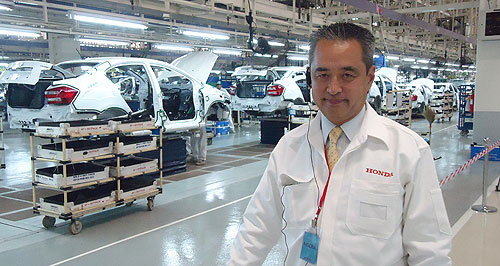News - HondaThai flood nightmare ends for HondaSight for sore eyes: Honda Australia managing director Satoshi Matsuzawa visits the re-opened Honda factory in Thailand to see production restored. Massive Thai rebuilding effort set to restore Honda shipments to Australia in weeks2 Apr 2012 HERCULEAN around-the-clock repair efforts by thousands of Honda engineers and factory workers at the company’s flood-devastated Thai factory will mean Honda Australia’s severely depleted vehicle line-up will be back on track by June – months earlier than predicted. The first fresh Thai-made CR-Vs and Civics for Australia since October last year are scheduled to arrive in late May from the Honda Automobile Thailand factory at Ayutthaya, outside Bangkok, which was swamped by up to 2.5 metres of water for 45 days in last year’s Thai floods. Shipments of Jazz, City and Accord will follow in June, although all Thai-made cars initially will come only in the three most popular colours – white, black and silver – to help speed production. The shipments will mark the end of months of pain for the local importer and its dealers, who lost the source for 80 per cent of their sales volume overnight when flood waters overwhelmed levees and poured into the factory in October, ruining 80 per cent of the equipment, including every high-tech robot. When flood waters finally receded and Honda engineers were able to access the factory in late November, they estimated Honda’s south-east Asian car-making hub would be out of action for up to 12 months.  Left: Honda Automobile Thailand. Below: Asian Honda president and CEO Hiroshi Kobayashi. Left: Honda Automobile Thailand. Below: Asian Honda president and CEO Hiroshi Kobayashi.However, Honda flew in an army of Japanese engineers and production equipment supplier staffers who with the help of Thai factory workers – 80 per cent of whom suffered flood damage to their own homes – had the factory up and running in just three months. The plant was officially reopened by Thai prime minister Yinluck Shinawattra at the weekend, in a ceremony high on emotion for the workers who were all kept on full wages by Honda during the flood and recovery operation. Some of the production equipment in the refurbished factory was diverted from new factories in Indonesia and Japan to the mud-caked Thai plant, which was so damaged that even the electrical wiring had to be replaced. While engineers worked on replacing and refurbishing the production equipment, the 6300 Thai assembly workers set about restoring the factory building, literally from the floor up. Thousands of tonnes of mud had to be washed away, and then hectares of blistered floor paint had to be scraped away by workers on their hands and knees before it was repainted. Asian Honda president and CEO Hiroshi Kobayashi said the plant had not just been swamped, but damaged by the pressure of the incoming water, in a similar way to the tsunami damage seen in Japan after last year’s earthquakes. He said that, despite the devastation – not just to the Honda plant but to surrounding suppliers in the Rojana industrial estate – Honda had never seriously considered shutting the factory and rebuilding elsewhere, because the cost and delay would have been prohibitive. Instead, a 77km levee system is being built around the industrial park before the next monsoon season starts in September to ensure a repetition of the event is less likely. Longer term, Honda may build another factory at a more secure location in Thailand. All of the Thai-built models previously made at the factory for Australia will go back into production there, and temporary sourcing of the new Civic sedan and Jazz from Japan will cease. Mr Kobayashi singled-out the Australian government for thanks, saying it had helped Honda to homologate Japanese-made Honda Jazz and Civic cars for Australia in record time, avoiding an even worse drought of Honda cars in Australian showrooms. However, dealers have been without fresh stocks of CR-V, Accord and City, helping to depress sales by 13.1 per cent so far this year and hurting Honda Australia’s bottom line. Honda Australia managing director Satoshi Matsuzawa predicted a “terrible” result for the 2011-12 financial year – which coincidentally ended on Saturday as the restored factory was being opened –but he said the prospects for the new fiscal year were much more promising. He said Honda Australia had a 2012 sales target of 40,000 vehicles, up from 30,000 last year when volumes were also impacted by the Japanese earthquake and tsunami, contributing to a slump of 25 per cent over 2010. Sales will be boosted by the arrival later in the year of the new-generation CR-V. Until then, the current model will be shipped from the refurbished Thai plant, getting Honda dealers back into the SUV business after months without stock. Honda Australia has to wait in line behind Thailand for stocks of vehicles, as the Thai dealers literally have no cars to sell because they offer only locally built vehicles. The two Honda Automobile Thailand production lines have resumed at 30 per cent capacity to ensure everything is in full working order again, but within three weeks the plant should be back running at full capacity of 1000 vehicles a day. Mr Kobayashi said the six-month production shutdown since October had cost Honda an estimated 200,000 vehicles. It now had a backlog of about 60,000 orders, which should be cleared in two to three months, depending on the model. Remarkably, he said Thai dealers had their best February on record in terms of customer orders as the local market anticipated the production re-start and the return of the City light sedan, which had just been facelifted when the floods struck. Mr Kabayashi said every Thai customer in the queue for a Honda car when the floods stopped production had been visited personally by both Honda and dealer representatives, who apologised for the delay and promised to get their car to them as soon as possible. “The customer is king,” he said. “Without customers, we can’t do anything.” He said this had a beneficial effect on Honda-customer relations, with most customers retaining their order, and Honda expected the exercise to help in future sales. Mr Kobayshi – who said he had inspected the flood factory by boat at the height of the deluge – declined to disclose the financial cost of the flood on Honda, saying only that a write-down would be necessary in the 2011-12 financial results that would be disclosed in a few weeks. He said insurance coverage for the factory flood damage was also being sorted with the insurance companies. Regardless of the insurance claim, Honda had pressed on with the factory repair because it could not afford to wait, he said. More than 1000 newly built cars drowned in the holding yards – and subsequently crushed as they were unsaleable – were covered by insurance. Honda will give 1000 Thai baht ($A31) from every Honda car sold in Thailand to a special fund established by the company for disaster relief in any future calamities in the country.  Read more |
Click to shareHonda articlesResearch Honda Motor industry news |
















Facebook Twitter Instagram